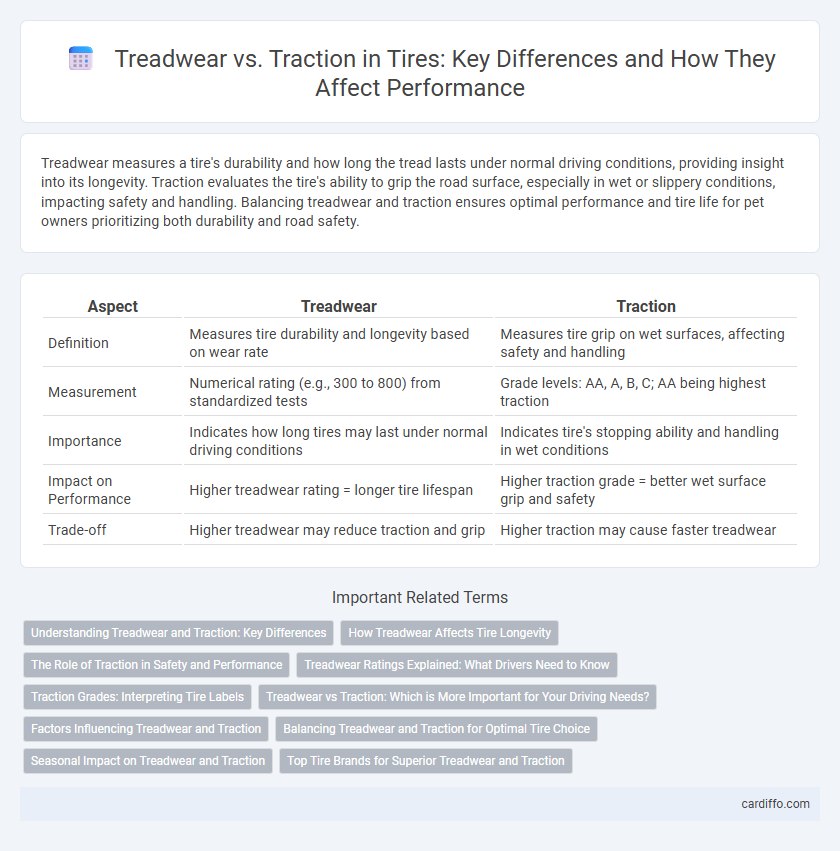Treadwear measures a tire's durability and how long the tread lasts under normal driving conditions, providing insight into its longevity. Traction evaluates the tire's ability to grip the road surface, especially in wet or slippery conditions, impacting safety and handling. Balancing treadwear and traction ensures optimal performance and tire life for pet owners prioritizing both durability and road safety.
Table of Comparison
| Aspect | Treadwear | Traction |
|---|---|---|
| Definition | Measures tire durability and longevity based on wear rate | Measures tire grip on wet surfaces, affecting safety and handling |
| Measurement | Numerical rating (e.g., 300 to 800) from standardized tests | Grade levels: AA, A, B, C; AA being highest traction |
| Importance | Indicates how long tires may last under normal driving conditions | Indicates tire's stopping ability and handling in wet conditions |
| Impact on Performance | Higher treadwear rating = longer tire lifespan | Higher traction grade = better wet surface grip and safety |
| Trade-off | Higher treadwear may reduce traction and grip | Higher traction may cause faster treadwear |
Understanding Treadwear and Traction: Key Differences
Treadwear measures a tire's durability and how long its tread lasts under standardized testing, indicated by the Uniform Tire Quality Grading (UTQG) rating. Traction refers to a tire's ability to grip the road surface, especially in wet or slippery conditions, classified from highest to lowest as AA, A, B, or C in the UTQG system. Understanding the key differences helps consumers balance longevity with safety based on their driving needs and conditions.
How Treadwear Affects Tire Longevity
Treadwear significantly impacts tire longevity by determining how long the tread remains effective under typical driving conditions. Tires with higher treadwear ratings tend to last longer, providing extended mileage before needing replacement, while those with lower ratings offer enhanced traction but wear out faster. Understanding the balance between treadwear and traction helps drivers choose tires that best match their durability expectations and driving needs.
The Role of Traction in Safety and Performance
Traction plays a crucial role in tire safety and performance by determining the tire's ability to grip the road surface, especially in wet or slippery conditions, reducing the risk of skidding and hydroplaning. While treadwear measures the durability and longevity of the tire, high traction ensures better handling, braking, and cornering stability, directly impacting vehicle control. Optimizing traction enhances overall driving confidence and safety, making it a critical factor for tire selection beyond just treadwear ratings.
Treadwear Ratings Explained: What Drivers Need to Know
Treadwear ratings indicate the expected durability of a tire's tread compared to a control tire, with higher numbers representing longer-lasting tires. While traction ratings measure a tire's ability to stop on wet surfaces, treadwear ratings help drivers understand how long the tire will perform under normal driving conditions. Choosing tires with balanced treadwear and traction ratings ensures optimal safety and longevity on the road.
Traction Grades: Interpreting Tire Labels
Traction grades on tire labels indicate the tire's ability to stop on wet pavement, rated from highest to lowest as AA, A, B, and C by the Department of Transportation. These grades provide critical information for drivers prioritizing wet traction performance to enhance safety during rain or slick road conditions. Understanding treadwear and traction grades together helps consumers balance tire durability with wet traction efficiency for optimal driving performance.
Treadwear vs Traction: Which is More Important for Your Driving Needs?
Treadwear measures a tire's durability and how long it will last under normal driving conditions, while traction indicates the tire's ability to grip the road on wet or slippery surfaces. Drivers who prioritize safety in rainy or icy conditions should focus on traction ratings, typically labeled as AA, A, B, or C, whereas those seeking long-term cost efficiency might consider higher treadwear ratings for extended tire life. Balancing treadwear and traction based on your driving environment and habits ensures optimal performance and safety.
Factors Influencing Treadwear and Traction
Tire treadwear is primarily influenced by factors such as rubber compound hardness, driving habits, and road conditions, with softer compounds generally wearing faster but offering better traction. Traction depends on tread pattern design, rubber compound grip, and tire temperature, which affects the tire's ability to maintain contact with the road surface. Balancing treadwear and traction involves selecting tires engineered to optimize compound composition and tread design for specific driving environments and safety requirements.
Balancing Treadwear and Traction for Optimal Tire Choice
Balancing treadwear and traction is essential for selecting tires that provide both durability and safety. Tires with higher treadwear ratings offer longer lifespan but may sacrifice grip, while those with superior traction ratings enhance handling and braking performance, especially in wet conditions. Choosing a tire involves evaluating the compromise between extended tread life and optimal traction to meet driving needs and road conditions effectively.
Seasonal Impact on Treadwear and Traction
Tire treadwear and traction are significantly influenced by seasonal conditions, with colder temperatures accelerating tread rubber hardening, leading to increased wear and reduced grip. In summer, softer tread compounds maintain better traction but are more prone to wear under high heat and abrasive road surfaces. Understanding these seasonal impacts helps optimize tire performance and lifespan by selecting appropriate tread designs and rubber compounds for specific weather conditions.
Top Tire Brands for Superior Treadwear and Traction
Top tire brands like Michelin, Bridgestone, and Goodyear consistently deliver superior treadwear and traction, enhancing safety and longevity on the road. Michelin's EverGrip technology ensures exceptional traction even as tread wears, while Bridgestone's proprietary compounds provide balanced durability and grip. Goodyear's Assurance line combines advanced tread patterns and rubber compounds to optimize both wet and dry traction alongside extended tread life.
Treadwear vs Traction Infographic

 cardiffo.com
cardiffo.com